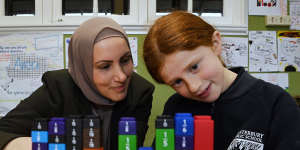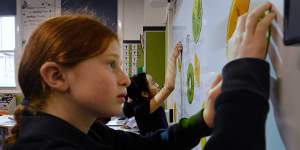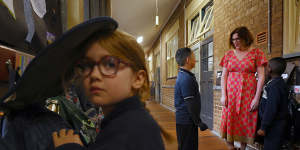The latest round of literacy and numeracy exams shows the school has gained ground in both measures:the proportion of year 3 children above baseline standard in reading is up from 59 per cent to 87 per cent.

Canterbury Public School teacher Rama Matar with year 3 student Anouk Jago during a lesson on fractions.Kate Geraghty
“We’ve targeted teacher practice with intensive professional development and making sure every teacher is trained in phonics instruction,” she said. “Parents have come along with us. We run workshops for families on core maths and reading concepts so they can help their kids at home.”
Considine said the school,which uses,had also worked hard to shift perceptions among teachers and parents that children “were either good at maths or they weren’t”.
“We’ve debunked myths and changed attitudes. We dispelled myths that only boys can achieve at the highest level in maths. Teachers now have high expectations of all students.”
The NSW Education Department has identified Canterbury for achieving significant growth in both reading and numeracy in the past year. About 80 per cent of year 3 students achieved proficiency in year 3 maths.

Year 3 students at Canterbury Public School during a maths lesson.Kate Geraghty
Last week’s release of the 2024 NAPLAN results painted a bleak picture of academic achievement across the country. One in three children in NSW failed to reach benchmarks in reading and maths. Ten per cent of year 9 pupils are functionally illiterate.
About 40 per cent of year 3 students did not meet expected standards in grammar tests,meaning they struggled to point out the correct location of a full stop or to identify proper nouns.
While Canterbury’s results are showing signs of bucking the statewide trend,outcomes nationally remain unchanged compared with 2023. The results once again lay bare the glaring gap between rich and poor students,and those in cities and remote areas.
The national scorecard has also intensified the fight between federal Education Minister Jason Clare and his state counterparts over the next schools funding deal.

Clare wants to tie the next injection of Commonwealth cash for schools to evidence-based teaching practices,phonics and numeracy screening checks and catch-up tutoring.
He has offered the states $16 billion,a 2.5 per cent increase,over the decade as part of the next Better and Fairer Schools Agreement. NSW and several other states have rejected that,demanding the federal government double that offer.
State ministers have until the end of September to indicate if they will sign on,and if they refuse,current funding arrangements will roll over for another year.
The stand-off continued this week when NSW Education Minister Prue Car and ministers from Victoria,South Australia,Queensland and the ACT gathered outside Parliament House with the Australian Education Union to lobby for more funding.

Canterbury Public School principal Tracy Considine.Kate Geraghty
In a letter sent by Car to 28 Labor MPs and senators on Wednesday,she says the “remaining funding gap puts the state’s public school students $1000 behind the starting line”.
“Education is a cornerstone of Labor governments,and it should be delivered equitably,with no child left behind,” she wrote.
Clare,whose offer would raise the Commonwealth’s long-standing share of funding for public schools from 20 per cent to 22.5 per cent,has said there are “no blank cheques” and that extra funds must be linked to reforms to help struggling children catch up with their classmates.

Professor Stephen Lamb,a member of the expert panel that advised the federal government on the next agreement,said funding shortfalls were damaging education and undermining reforms.
“But more money alone won’t change things. Governments need far greater oversight over where funding is being directed,” he said.
“In the decade since Gonksi,governments have not effectively used funding to reduce inequality. We don’t know enough about where the money went,what it was spent on. We need to ensure money is spent on the things that will lift results and reduce inequality.”
Despite the fact that more than $600 billion had been injected into schools over the decade since the Gonksi reforms were initiated,there has been little evidence of significant improvement in results.
High-quality teaching,effective and evidence-based teacher training was critical,Lamb said. This was especially needed in disadvantaged schools where chronic vacancies persisted.
“The proportion of students from disadvantaged backgrounds who are not at the national standard needs,ideally,to be halved within 10 years,” he said.
He believes while it is vital to identify teaching practices and conditions that will facilitate improvement,governments are not guaranteeing the resourcing and staffing is targeted to achieve that.
Jordana Hunter,another member of the expert panel,who is also director of education at the Grattan Institute,said decades of infighting about how to teach reading had contributed to many students missing out on best-practice teaching.
“Australia should also have a long-term goal of 90 per cent of students meeting proficiency in reading. This would greatly reduce inequity,” she said.
The NSW Education Department has said it wanted more explicit and evidence-based teaching to be used in schools. It has mandated phonics teaching from kindergarten and is rolling out major syllabus reform to focus on knowledge before skills.
However,Car has removed the accreditation process for all teacher professional development;and slashed school budgets by $148 million.
TheHerald revealed last month that a breakdown of NAPLAN results by state electorate shows the worst-performing areas are about seven academic years behind the top-achieving schools by the time children reach year 9.
At Canterbury,Considine said a focus on explicit teaching - a back-to-basics teaching method where students are given clear,step-by-step instructions - has helped ensure every child was equipped to make the transition from year 6 to year 7.
“In 2019,we started an intensive reading program to help kids slipping behind. There are now fewer and fewer kids being earmarked for that program,” she said.
She said the school’s professional development for teachers had been run in-house by the school’s assistant principal in curriculum instruction.
“We make sure students are reading each night. We’ve really nailed down phonics to help every child become a fluent reader,” she said.
Start the day with a summary of the day’s most important and interesting stories,analysis and insights..